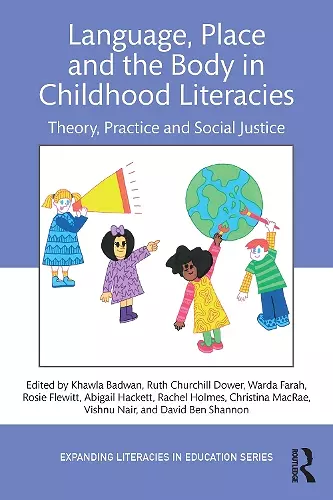Language, Place, and the Body in Childhood Literacies
Theory, Practice, and Social Justice
Rachel Holmes editor Abigail Hackett editor Khawla Badwan editor Rosie Flewitt editor Christina MacRae editor Ruth Churchill Dower editor Warda Farah editor Vishnu KK Nair editor
Format:Paperback
Publisher:Taylor & Francis Ltd
Published:21st Aug '25
Currently unavailable, and unfortunately no date known when it will be back

Challenging dominant views of early childhood language development and knowledge, this thought-provoking volume illuminates the importance of place, the body, and movement in opening space for young children’s improvisatory, creative, playful language practices.
Bringing together a rich collection of contemporary research and diverse perspectives, the book centers on the premise that ‘where’ talk happens—be it spoken, mimed, signed, or assisted through one or more communication tools—is not a neutral backdrop or controllable variable. Rather, it is deeply entangled in the emergence of language from bodies, in how these vocalizations make their way into the world, what they might feel like and set into motion, and how they are received, heard and listened to by other humans and by non-humans. Chapter authors introduce theories about language, body, and place, while also providing examples of what this work may look like in practice.
This book is key reading for those who work with young children and families, including teachers, pre-service teachers studying child development, speech and language therapists, support workers, and those in the arts, cultural and environmental sectors. It is also highly relevant to researchers, literacy education scholars, and anyone who endeavors to think more expansively and critically about language and literacy in early childhood contexts.
'This exemplary book goes far beyond simple meanings and interpretations about language, to reconceptualise language as multimodal and embodied in spoken and signed words, created with machines and symbols, danced, painted … and always connected to place. The interdisciplinary authors are academics, pedagogues, located in communities and various practitioners who give us new insights into how children create their own language in their unique learning ecologies and share what this actually looks like in their lifeworlds.'
- Nicola Yelland, Professor of Early Childhood Studies, University of Melbourne, Australia
'If “it takes a village to raise a child,” this book powerfully shows that it is not only the people in the village, but the land, objects, and the whole host of non-human beings there who shape this development. The book demonstrates that language and cognition are embodied, shaped by an ecology of expansive social and material resources. How children draw from all the resources in their environment to think and talk in creative, spontaneous, and unorthodox ways suggests a complex language development. Judging their communication as deficient stems from our limited ideological assumptions. This book educates scholars to expand their perspectives by listening to the more-than-human communication “out of the mouth of babes and infants”!'
- Suresh Canagarajah, Evan Pugh University Professor, Pennsylvania State University, USA
'If you are interested in how, why and when children communicate, you will be informed, provoked, stimulated and engaged by this collection of papers. Rejecting simple and reductive approaches, the authors collectively show that children’s languaging practices are full-bodied, material, placed, unpredictable and delightfully opaque and slippery.'
- Pat Thomson, Professor of Education, The University of Nottingham, UK
ISBN: 9781032620756
Dimensions: unknown
Weight: 520g
256 pages